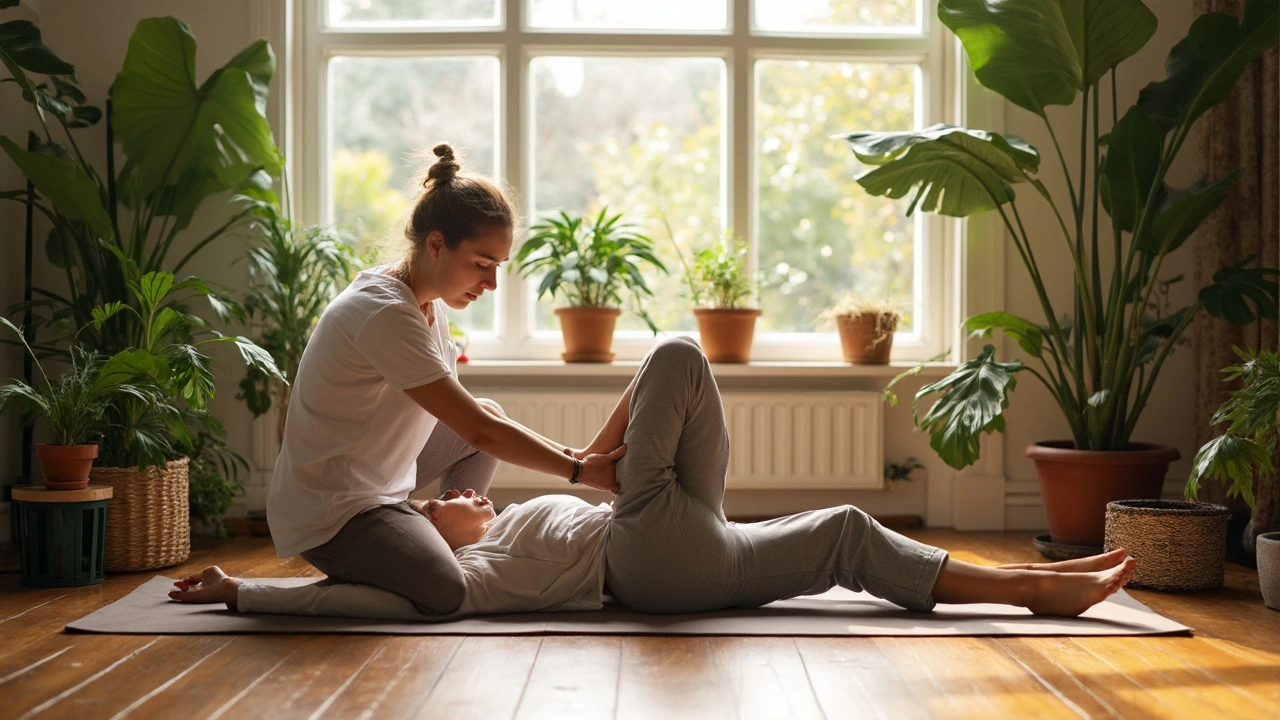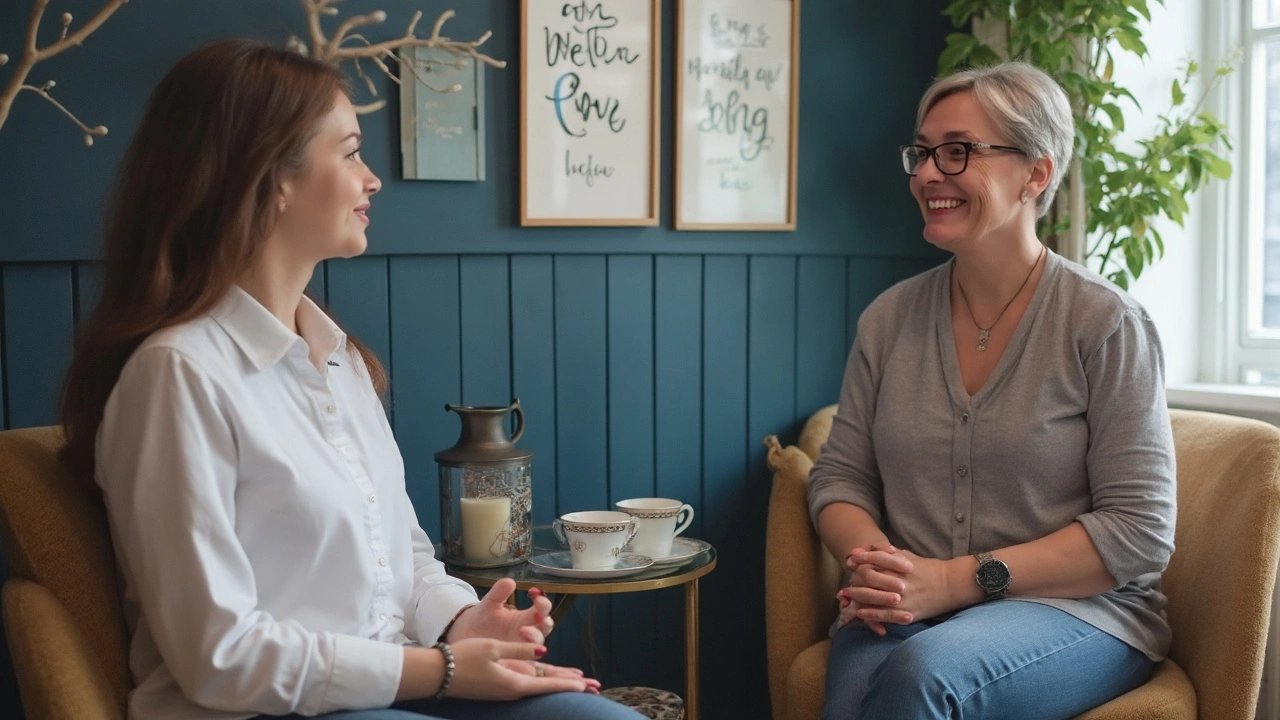Rolfing for Stress Relief: The Truth About Structural Integration and Relaxation
 Aug, 10 2025
Aug, 10 2025
Ever feel like your body is one giant knot, like you’ve wound yourself so tight that even yawning feels like a risky move? There’s no shortage of ways to smash stress, but the options start looking the same after a while: massage, yoga, meditating while your neighbor’s lawnmower drowns out your zen playlist. But there’s something you might not have tried—rolfing. Yes, that’s really what it’s called. It promises deep relief by literally reshaping the body’s structure. Sound wild? Let’s unpack exactly what rolfing is, why people swear it melts their stress, and what actually happens once you’re on the table.
What is Rolfing? Beyond the Strange Name
Rolfing, officially known as Rolfing Structural Integration, was created by Dr. Ida Rolf back in the 1960s when the counterculture was trying just about everything to feel more human. The core idea is surprisingly practical: your fascia—the webbing that wraps around your muscles and organs—gets tight or scrunched up. When it does, your posture changes and tension builds up, sometimes causing pain or making you more likely to stress out. Unlike a traditional massage, which usually targets relaxation and short-term pain relief, rolfing helps straighten out the fascia itself. Think of it as deep bodywork mixed with a precision tune-up for your frame. Fans of rolfing often talk about their bodies feeling ‘open’ or ‘lighter’ afterward, like someone took the bricks out of their backpack.
The science here is catching up slowly. Multiple small-scale studies have shown improvements in flexibility and posture. One German study from 2017 found that participants who completed a standard ten-session rolfing series reported less bodily pain and some improvements in emotional well-being—two big wins in the stress department. Fascia, once thought of as just packing material for your body, is now recognized as a living tissue network that’s constantly communicating with your nervous system. When that network gets wound up, your whole stress response can go sideways.
So, how does it work? A certified rolfer (yes, that’s the official title) uses their hands, knuckles, and sometimes elbows to work through the fascia along specific lines of tension. People sometimes say it ‘hurts so good.’ Sessions are done with you wearing minimal clothing—shorts and a sports bra or underwear—because the practitioner needs to see and feel the body’s alignment. A typical rolfing course goes through ten sessions, each focusing on different body areas and goals, ranging from decompressing your chest (hello, desk-job life) to freeing up your neck, jaw, and even your feet. Rolfing can feel intense—this isn’t a nap-on-the-table spa massage. The results, however, can be pretty remarkable: folks report not just physical ease but also emotional lightness, probably because our brains and bodies are way more linked up than we usually admit.
If you’re already skeptical about crunchy ‘alternative’ therapies, the mainstream world is, too. But, since the pandemic, you’ll find athletes, office workers, and even surgeons in Salt Lake City chatting about their last rolfing session. And that’s not just gossip. Dr. Rolf’s early work earned her a research post at the Rockefeller Institute in the 1940s—she wasn’t just riffing from her garage. She believed that freeing the body from tension could help people move better and, yes, feel way less stressed. In 2022, a review of fascia therapies published in "Frontiers in Physiology" highlighted the real links between myofascial treatment and improved nervous system function. In plain English: relaxing the fascia can lead to a calmer you.
If you’re looking for something more ‘manual’ than meditation but deeper than a Swedish massage, rolfing sits right at that intersection. You’ll want to check that your practitioner has credentials from the Dr. Ida Rolf Institute, as this field is very hands-on and skill varies a lot. Don’t go to someone uncertified—you wouldn’t go to a fake plumber to swap your kitchen pipes, right?

Rolfing vs. Massage: Is It Really Better for Stress?
Okay, so why not just get a massage? It’s a fair question because there’s a lot of overlap—rolfing looks like a deep-tissue massage, but the method (and the results) are different. Picture it this way: If a massage is a short-term fix for tired muscles, rolfing is an attempt to redesign the whole building, not just patch the wall. While a regular massage therapist focuses on muscle relaxation and blood flow, a rolfer targets fascia, aiming for long-term change in posture and movement.
Massage therapists usually chase tension where it hurts. Rolfers explore the cause of that tension—sometimes it’s a hunched back from years of stress or a misaligned pelvis from a past injury. The process can feel more intense and sometimes more emotional. Research in the "Journal of Bodywork and Movement Therapies" in 2019 showed people who underwent rolfing recorded positive shifts in anxiety levels, especially after several sessions. The body and brain are tight-knit; changing how you move can shift how you feel.
Here’s something you might not expect: Rolfing can sometimes make you emotional. When fascia releases, so does pent-up stress—think of the sore shoulders you’ve carried since that terrible family Zoom call last Thanksgiving. Some folks say they feel like crying mid-session, while others just feel a fresh sense of clarity or lightness. That’s not magic; it’s a mind-body chain reaction.
Now, let’s talk results. One of the biggest benefits of rolfing for stress isn’t just physical relief—it’s the postural awareness that develops. You’ll start moving with more intention. Your body remembers old habits—a slouch, clenched jaw, or a nervous shuffle. Rolfing calls out these patterns and helps you shift them. Over time, your energy flows differently, your breathing improves, and yes, stress seems a little less able to dig in its claws.
Massage therapy is fantastic for hitting pause and pressing reset on acute tension. But if you want to stop tension from coming back again and again, you might find the structural changes from rolfing are much longer lasting. Still, it’s not always love at first poke—rolfing isn’t a quick fix or a one-off treat. The ten-session program isn’t just for tradition; it’s about letting the body slowly shift and adapt, without shocking the system.
There are risks, of course. Some people feel sore or bruised after a session, especially if they jump in with pre-existing injuries or conditions like fibromyalgia. If you’re dealing with a major health issue (blood clots, osteoporosis, open wounds), talk with your doctor first. An experienced rolfer will ask about your health history and won’t push you into anything that feels really wrong.
People sometimes ask, “How do I know if it worked?” The giveaway is usually stuff you didn’t even notice was bugging you—maybe you’re sleeping better, or your posture at the computer is suddenly less painful. Sometimes it’s not epic, just a slightly better mood and a bit less anxiety at the end of a rough week. That’s meaningful, especially in a world where stress is basically a normal part of the background noise.
Bottom line: If your stress shows up as tight shoulders, clenched fists, or chronic aches—rolfing may dig deeper than a regular massage. You might just stand taller, breathe easier, and feel more like yourself.

Tips for Your First Rolfing Session and What to Expect
Nervous for your first session? Most are. The image of someone leaning elbows-first into your back is a little intense, but knowing what goes down can make it easier. Here’s the inside scoop.
First, wear something comfy but minimal: shorts or swim trunks for guys, and for women, a sports bra and shorts work well. The rolfer will want to see how you stand and move to spot problem areas. You’ll likely be asked to walk, stand, and maybe even squat or do small stretches while they observe. Rolfers aren’t judging your beach bod—they’re just mapping out patterns of how you hold yourself and where tension hides.
The hands-on part can feel pretty firm, especially if you’re used to spa massages. Rolfers use precise, slow pressure—sometimes even working around deeply sensitive spots. If you need a break, say so. Communication matters; they want feedback if a touch feels too sharp or not deep enough. Unlike some therapies, rolfing invites you to engage—you might be asked to breathe a certain way, turn your head, or stretch a limb to help access specific fascia lines.
The ten-session series is called ‘the recipe.’ Each session has a focus. The first works on freeing the chest and breath—the better to shed daily stress and tension. The next few sessions might address feet, legs, back, and neck in turn. By session six, you could feel taller or lighter, and many people say old aches and stress get replaced with a sense of ease. Nobody gets ‘fixed’ in one go, so try to stick out the full series if you give it a try.
Can you combine rolfing with other therapies? Absolutely. Many folks in Salt Lake City alternate rolfing with regular yoga, occasional acupuncture, or even weekly runs around Liberty Park. You don’t have to choose—let your body tell you what combo works best. And yes, you can keep seeing your doctor or chiropractor. Rolfing isn’t a substitute for medical care, but a complement for chronic stress patterns that medicine alone doesn’t erase.
Money talk: Sessions typically run $100 to $200 each in the U.S., depending on where you live. Some insurance plans may cover it if prescribed for pain or rehab, but don’t count on that. There are package deals if you commit to the full series, so ask up front about pricing before you get hooked. If money’s tight, explore scheduling sessions less frequently—it won’t disrupt the recipe, but it might take a bit longer to see big changes.
What about the emotional side? You might process memories, dreams, or stress during or after a session. That’s normal—your body stores more than just tension. Drink plenty of water, give yourself some chill time after each session, and don’t plan heavy workouts right after. Let the new patterns settle in before throwing your body back into chaos.
The best tip: Find a rolfer you trust and feel safe with. Chat beforehand, ask questions, explain your goals and any hesitations. Check their credentials on the Dr. Ida Rolf Institute website. If something feels off in the first session, don’t be afraid to try another practitioner. Chemistry matters a ton in bodywork.
If you want to take your results up a notch, try little posture check-ins during the day. When you catch yourself hunching or clenching, pause, inhale deeply, and gently shift your position. Over time, these small resets add up, especially if your body’s learning new balance from each session.
So, if traditional “chill out” tricks aren’t giving you relief, rolfing is worth a shot. It dives under the surface to untangle what stress does to your body, helping you walk out feeling a bit more human again. And who couldn’t use that, even just for an hour a week?
